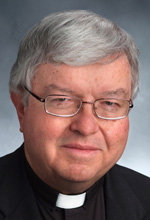Q. I recently began attending Mass at a Catholic parish in my neighborhood. After I had been there several times, the priest made a speech saying that, since there were no kneelers in that church, no one was allowed to kneel during Mass — even during the consecration or after receiving the holy Eucharist. To do so, he said, would be disrespectful to other parishioners. I was very upset, as I am in awe of receiving my Lord’s actual body and blood and feel called to fall on my knees. Is it the accepted practice of the Catholic Church to be able to tell people how they can and cannot worship? (Quinque, Va.)
A. The General Instruction of the Roman Missal serves as the universal guidebook for the manner in which Catholics throughout the world celebrate Mass. It specifies that national conferences of bishops are empowered to determine the postures of worshippers during the celebration, a provision that wisely allows for regional differences in customs.
In the United States, the bishops’ conference has decided that the congregation should kneel during the eucharistic prayer and stand for the reception of Communion (with a slight reverential bow just before taking the Eucharist).
Standing is the posture that has, from the earliest days of the Church, signified that we share in Christ’s resurrection, and standing for Communion shows that we are about to be united to Jesus, now gloriously risen.
[hotblock]
The significance of kneeling has, in the Church’s history, undergone a transformation. At first, it was seen as demonstrating penance, and early Christians were forbidden to kneel on Sundays and during the Easter season, when joy was the prevailing spirit of the liturgy. During the Middle Ages, kneeling came to signify the homage of a vassal to his lord. Now, kneeling in the liturgy denotes adoration.
Exceptions to the guidelines are envisioned as, for example, when someone is prevented from kneeling because of ill health, or for lack of space or “for another reasonable cause,” as noted in the general instruction missal. Not infrequently, Mass is celebrated in a multipurpose building that has folding chairs and no kneelers. In such a case, worshippers could logically be excused from kneeling, which is what your pastor has evidently done.
His desire for uniformity is supported by the general instruction missal, which states in No. 42 that “a common bodily posture, to be observed by all those taking part, is a sign of the unity of the members of the Christian community gathered together for the sacred liturgy.”
For the same reason, the U.S. bishops state on the www.usccb.org website that “we are not free to change these postures to suit our own individual piety, for the Church makes it clear that our unity of posture and gesture is an expression of our participation in the one body formed by the baptized with Christ, our head.”
I believe that this plea for uniformity has to be viewed in a pastoral context. It is one thing when safety is at stake. (In our parish, which has a sloped aisle, one man insists on genuflecting suddenly just before taking Communion, the result being that the person just behind him in line is hard-pressed not to tumble on top of him.)
But if an individual worshipper simply prefers to kneel when others are standing, that’s pretty far down on my list of things to worry about. Since only 22 percent of American Catholics now attend Mass once a week or more, I’m just thankful that somebody is in church.
***
Questions may be sent to Father Kenneth Doyle at askfatherdoyle@gmail.com and 40 Hopewell St., Albany, N.Y. 12208.
PREVIOUS: Pope Benedict XVI’s Prayer Intentions for August
NEXT: Gleaning the fields, with help from Catholic Heart Work Campers




Share this story